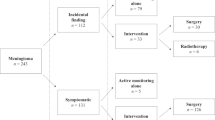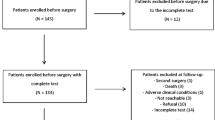Abstract
The objective of this study was to determine the subjectively reported quality of life (QOL) of patients with meningiomas surgically treated. Demographic, medical and outcomes data on 164 patients were retrospectively analyzed with the use of the Brain Tumor Center database at the Brigham and Women's Hospital, Boston, MA. The patients were contacted via a telephone survey and were asked 26 standardized QOL questions based on a modification of the validated Functional Assessment of Cancer Therapy–Brain (FACT–BR) Study, which used only questions adjuvant to brain tumor patients.
The patients’ ages ranged from 23 to 87 years. The mean follow-up time after intracranial surgery was 33 months and median follow-up time was 28 months, with a range of 0 to 165 months. Of those 164 patients still living, 95% (155) participated in the telephone survey. 80% reported being satisfied with their post-treatment quality of life; 86% reported that they could write, read, drive and return to work at their pre-morbid level of functioning; 87% described themselves as ‘independent’ and able to act on their own initiatives.
Our study found a high level of satisfaction for QOL in patients who have undergone surgery for intracranial meningiomas. Patients, by their own report, are able to lead independent, personally satisfying, meaningful and productive lives. This provides useful information to share with patients in discussions regarding surgical treatment of these lesions.
Similar content being viewed by others
References
Burger PC, Vogel FS: Surgical Pathology of the Nervous System and its Coverings. J. Wiley, New York, 1991, pp 65-70
Carroll RS, Glowacka D, Dashner K, Black PM: Progesterone receptor expression in meningiomas. Cancer Res 53: 1312-1316, 1993
Earle KM, Richany SF: Meningiomas: a study of the histology, incidence, and biologic behavior of 243 cases from the Frazier-Grant collection of brain tumors. Med Ann DC 38: 353, 1969
Schmidek HH: Meningiomas and their surgical management. WB Saunders and Harcourt Brace Jovanovich, Philadelphia, 1991, pp 48-62
New PF, Aronow S, Hesselink JR: National Cancer Institute study: evaluation of computed tomography in the diagnosis of intracranial neoplasms. IV. Meningiomas. Radiology 136: 665-675, 1980
Bradac GB, Ferszt R, Bender A, Schomer W: Peritumoral edema in meningiomas. A radiological and histological study. Neuroradiology 28(4): 304-312, 1986
Bitzer M, Wockel L, Luft AR, Wakhloo AK, Petersen D, Opitz H, Sievert T, Ernemann U, Karsten V: The importance of pial blood supply to the development of peritumoral brain edema in meningiomas. Neurosurg Focus 2,(4), April 1997
Al-Mefty O: Meningiomas. Raven Press, New York, 1991, pp 59-73, 273-283
Black PM: Meningiomas. Neurosurgery 32: 643-657, 1993
Black P, Katherisan S, Chung W: Meningioma surgery in the elderly: a case-control study using morbidity and mortality. Acta Neurochirurgica 140: 1013-1017, 1998
Engelhard HH: Current status of radiation therapy and radiosurgery in the treatment of intracranial meningiomas. Neurosurg Focus 4(2), April 1997
Shafron DR, Friedman WA, Buatti JM, Bova FJ, Mendenhall WM: Linac radiosurgery for benign meningiomas. Int J Radiation Onc Biol Phys 43(2): 321-327, 1999
Barbaro NK, Gutin PH, Wilson CB, Sheline GE, Boldrey EB, Wara WM: Radiation therapy in the treatment of partially-resected meningiomas. Neurosurgery 20: 525-528, 1987
McCarthy BJ, Davis F, Freels S, Surawicz TS, Damek D, Grutsch J, Menck HR, Laws ER Jr: Factors associated with survival in patients with meningioma. Neurosurg Focus 2(4), April 1997
Percy AK, Elveback LR, Okazaki K, Kurland LT: Epidemiologic considerations. Neurology 22(1): 40-48, 1972
Sant K, Crosignani P, Bordo BM, Nicola G, Bianchi M, Berrino F: Incidence and survival of brain tumors: a population-based study. Tumori 30; 74(3): 243-252, 1988
Mahaley MS Jr, Mettlin C, Natarajan N, Laws ER Jr, Peace BB: National survey of patterns of care for brain tumor patients. J Neurosurg 71: 826-836, 1989
Helseth A, Mork SJ: Primary intraspinal neoplasms in Norway, 1955 to 1986. A population-based survey of 467 patients. J Neurosurg 71: 842-845, 1989
Sankila R, Kallio M, Jaaskelainen J, Hakulinen T: Longterm survival of 1986 patients with intracranial meningioma diagnosed from 1953 to 1984 in Finland. Comparison of the observed and expected survival rates in a population-based series. (Published erratum appears in Cancer 15; 71(4): 1394, 1993) Cancer 70: 1568-1576, 1992
Preston-Martin S, Staples M, Farrugia H, Giles G: Primary tumors of the brain, cranial nerves and cranial meninges in Victoria, Australia, 1982-1990: patterns of incidence and survival. Neuroepidemiology 12(5): 270-279, 1993
Thier SO: Forces motivating the use of health status assessment measures in clinical settings and related clinical research. Med Care 30: Suppl MS15-MS22, 1992
Testa MA, Simonson DC: Assessment of quality-of-life outcomes. New Eng J Med 334: 835-840, 1996
Constitution of the World Health Organization. World Health Organization Handbook of Basic Documents, 5th edn. Geneva: Palais des Nations, 1952
Chan RC, Thompson GB: Morbidity, mortality, and quality of life following surgery for intracranial meningiomas. A retrospective study of 257 cases. J Neurosurg 60: 52-60, 1984
Sachsenheimer W, Bimmler T: Assessment of quality of survival in patients with surgically treated meningioma. Neurochirurgia 35: 133-136, 1992
Sachsenheimer W, Piotrowski W and Bimmler T: Quality of life in patients with intracranial tumors on the basis of Karnofsky's performance status. J Neuro-Onc 13: 177-181, 1992
De Jesus O, Sekhar LN, Parikh HK, Wright DC, Wagner DP: Long-term follow-up of patients with meningiomas involving the cavernous sinus: recurrence, progression, and quality of life. Neurosurgery 39(5): 915-919, 1996
Weitzner MA, Meyers CA, Gelke CK, Byrne KS, Cella DF, Levin VA: The Functional Assessment of Cancer Therapy (FACT) Scale: Development of a brain subscale and revalidation of the general version (FACT-G) in patients with primary brain tumors. Cancer 75: 1151-1161, 1995
Hutchinson TA, Boyd NF, Feinstein AR: Scientific problems in clinical scales, as demonstrated in the Karnofsky Index of Performance Status. J Chron Diseases 32: 661-666, 1979
van Knippengerg FCE, de Haes JCJM: Variance and dissent: measuring the quality of life of cancer patients-Psychometric properties of instruments. J Clin Epidemiol 41: 1043-1053, 1988
Aaronson NK: Methodologic issues in assessing the quality of life of cancer patients. Cancer 67: 844-850, 1991
Gotay CC, Korn EL, McCabe MS, Moore TD, Cheson BD: Quality-of-life assessment in cancer treatment protocols: Research issues in protocol development. J Natl Cancer Inst 84: 575-579, 1992
Padilla GV, Grant MM, Lipsett J, Anderson PR, Rhiner M, Bogen C: Health quality of life and colorectal cancer. Cancer 70: 1450-1456, 1992
Gitjenbeek JMM, Hop WCJ, Braakman R, Avezaat CJJ: Surgery for intracranial meningiomas in elderly patients. Clin Neurol Neurosurg 95: 291-295, 1993
Stewart AL, Ware JE, Brook RH: Advances in the measurement of functional status: Construction of aggregate indexes. Med Care 19: 473-488, 1981
Schag CC, Heinrich RL: CARES. Cancer Rehabilitation Evaluation System. Los Angeles, CA, Cares Consultants, 1988
Hays RD, Stewart AL: The structure of self-reported health in chronic disease patients. Psychol Assess 2: 22-30, 1990
Cella DF, Tulsky DS, Gray G, Sarafian B, Linn E, Bonomi A, Silberman M, Yellen SB, Winicour P, Brannon J, Eckberg K, Llyid S, Purl S, Blendowski C, Goodman K, Barnicle M, Stewart I, Mchale M, Bonomi P, Kaplan E, Taylor S IV, Thomas CR, Harris J: The Functional Assessment of Cancer Therapy scale: development and validation of the general measure. J Clin Oncol 11(3): 570-579, 1993
Author information
Authors and Affiliations
Rights and permissions
About this article
Cite this article
Kalkanis, S.N., Quiñones-Hinojosa, A., Buzney, E. et al. Quality of Life Following Surgery for Intracranial Meningiomas at Brigham and Women's Hosipital: A Study of 164 Patients Using a Modification of the Functional Assessment of Cancer Therapy–brain Questionnaire. J Neurooncol 48, 233–241 (2000). https://doi.org/10.1023/A:1006476604338
Issue Date:
DOI: https://doi.org/10.1023/A:1006476604338




